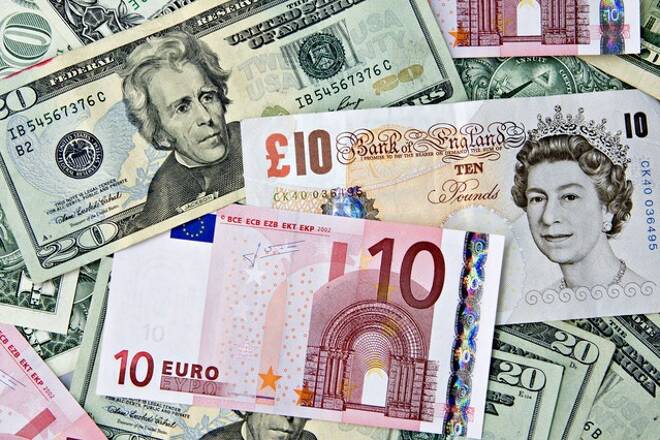Advertisement
Advertisement
EUR/USD Daily Technical Analysis for March 19, 2018
By:
The EUR/USD moved lower on Friday, hovering just below resistance, as Eurozone inflation moved lower, driving down the currency pair. The ECB’s Praet said
The EUR/USD moved lower on Friday, hovering just below resistance, as Eurozone inflation moved lower, driving down the currency pair. The ECB’s Praet said he is no hurry to change guidance, which also weighed on the currency pair. During the week, softer than expected inflation figures were released for the United States, which shows inflation remains subdued helping to cap the value of the greenback.
Technicals
The EUR/USD moved lower remaining below resistance near the 10-day moving average at 1.2347. The exchange rate has been rangebound nearly unchanged since January. Support on the currency pair is seen near and upward sloping trend line that comes in near 1.2240. A break would lead to a test of the February lows at 1.2154. Momentum has turned negative as the MACD (moving average convergence divergence) index generated a crossover sell signal. This occurs as the MACD line (the 12-day moving average minus the 26-day moving average) crosses below the MACD signal line (the 9-day moving average of the MACD line). The fast stochastic recently generated a crossover sell signal, which also reflects accelerating negative momentum.
Eurozone Inflation Was Revised Lower
Eurozone HICP inflation was revised down to 1.1% year over year with the final February numbers, from 1.2% year over year in the preliminary reading and versus 1.3% year over year in January. However, core inflation was confirmed at 1.0% year over year, unchanged from the preliminary reading and also steady versus January. The breakdown confirmed that the main reason behind the dip in the headline rate was a sharp deceleration in the pace of food price inflation in February, which fell back to 1.0% year over year from 1.9% year over year in the previous month.
Energy price inflation dipped to 2.1% year over year from 2.2% year over year, also adding to the decline in the headline rate. Core inflation has stayed steady, and even the doves at the council seem more confident that underlying inflation has turned a corner, which means the downward revision to the February number won’t deter the ECB to phase out net asset purchases this year, although the fact that Praet highlighted the chance that the slack in labor markets may be greater than official data suggests indicates that the core team around Draghi is eager to continue to move very slowly towards tighter monetary conditions.
ECB’s Praet not in a hurry to change guidance
The Executive Board member told Reuters that there are “a convergence between market expectations and” the ECB’s intended end data, with markets dont’ expecting the APP to continue much longer . So no push back against expectations that net asset purchases will be phased out this year. Praet also suggested that markets quantify the “well-past” interval between the end of net asset purchases and the first rate increase as “up to next spring, adding that “once you stop net asset purchases the signalling aspect of the asset purchase program disappears and you therefore have to be much more precipice about the future path of short term rates”. Praet admitted that the ECB cannot wait until September before clarifying what will happen after the end of the current QE schedule, but also seemed reluctant to commit too early, so we may have to wait until July before the ECB clarifies its path. At the same time Praet once again pointed to wider measures of underemployment and highlighted that there is strong evidence of a labour supply reaction with “more women, elderly and workers from central Europe joining the workforce”.
U.S. reported foreign accounts Declined
U.S. reported foreign accounts bought $119.7 billion in total net U.S. assets in January, largely unwinding the $122.5 billion in December of which private accounts bought $88.7 billion, while official accounts took $30.9 billion. In terms of long term securities, overseas accounts bought $62.1 billion after buying $23.3 billion in December . Of that, private accounts purchased $13.6 billion in Treasury coupons at the start of the year, along with $33.5 billion in equities and $17.1 billion in agency bonds, and sold $1.9 billion in corporate bonds. Official accounts sold $5.2 billion in longer term Treasuries and $300 million in corporate bonds, while they bought $5.4 billion in agency debt and $1 billion in equities. China was the largest seller of Treasuries in January at -$16.7 billion, followed by the UK with -$6.7 billion, and -$5.5 billion from Taiwan and -$5.3 billion from Russia.
About the Author
David Beckerauthor
David Becker focuses his attention on various consulting and portfolio management activities at Fortuity LLC, where he currently provides oversight for a multimillion-dollar portfolio consisting of commodities, debt, equities, real estate, and more.
Advertisement
